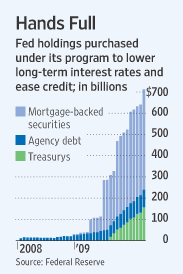Fed Manipulation Of Mortgage Rates Continues
Mortgage rates continue their downward trend with the perfect borrower now able to obtain a rate of 4.75% with a two point buy-down on a 30 year fixed rate mortgage. As expected, with mortgage rates now back in the 4% range, mortgage applications have increased. The latest stats from the The Mortgage Bankers Association show large increases in mortgage activity, with refinances accounting for almost 60% of total mortgage applications.
The Market Composite Index, a measure of mortgage loan application volume, increased 17.0 percent on a seasonally adjusted basis from one week earlier. On an unadjusted basis, the Index increased 15.8 percent compared with the previous week and 64.5 percent compared with the same week one year earlier.
While fluctuations in mortgage rates are historically based on many factors, the biggest factor affecting mortgage rates today are the manipulations by the Federal Reserve. With the mortgage market dominated by the government, it is difficult to determine where rates would be in a free market but indications are that rates would be much higher. For example, non agency lenders who do not sell mortgage loans to the government agencies but portfolio them instead, are currently quoting 30 year fixed rates at around 6 to 6.5% depending on credit and loan to value (obviously, the non agency lenders are not doing much conforming loan business).
Fed Price Fixing Efforts With Mortgages Will Fail
So what’s the problem with having low mortgage rates? The government manipulations in the mortgage market allow homeowners to refinance and buy at low rates. If mortgage rates drop low enough, perhaps the government will succeed in its objective of re-inflating housing prices. There just might be a few problems with the government’s manic quest to keep mortgage rates low.
- How long will investors continue to buy securities backed by mortgages on which payments are guaranteed by the government? Perhaps forever, but perceptions of the value of a “government guarantee” may diminish as the financial condition of the US Government continues to erode. At some point, rational buyers will give little credence to the guarantee of a government that needs to borrow 40% of its year outlays while running multi trillion dollar yearly deficits.
- How long can the Federal Reserve continue to purchase mortgage backed securities and treasury debt with printed money? It may not seem to be causing a problem in this country (yet) but some of the USA’s largest foreign creditors are getting very nervous – See China Alarmed By US Money Printing.
Banks Load Up On Mortgages
Theoretically, the Federal Reserve can buy every mortgage backed security in existence but at what point does the bond market react with higher rates based on the risk that the Fed is going to monetize debt on a colossal scale? Fed purchases of mortgage backed securities are fast approaching the announced goal of $1.25 trillion.

Courtesy wsj
As it turns out, the Fed has a willing and able partner in the purchase of mortgage backed securities. With the banking industry facing massive losses on defaulting mortgages, how is this for irony? – Banks Load Up On Mortgages.
As of June 30, the roughly 8,500 federally insured banks and thrifts were holding $113.5 billion of Ginnie securities, compared with just $41 billion a year earlier, according to a Wall Street Journal analysis of bank financial disclosures. It is the largest amount that banks have reported holding since at least 1994.
Banks, sometimes with the blessing of federal regulators, have been loading up on Ginnie securities for one main reason: They make their balance sheets look healthier. Since the securities are guaranteed by the government, federal banking regulators have deemed them risk-free, meaning that adding them to a bank’s investment portfolio, or replacing assets deemed riskier, lowers the overall risk of the portfolio in the eyes of regulators.
Some banks have used government cash infusions under the Troubled Asset Relief Program to buy Ginnie Mae bonds.
Holding Ginnie bonds help banks look better because federal bank-capital guidelines give the Ginnie securities a “risk weighting” of 0%. That means banks don’t have to hold any cash in reserve to protect against losses.
At the same time that the banks are choking on defaulted mortgages and reluctant to lend, they are purchasing vast quantities of government guaranteed mortgages to shore up their capital ratios, sometimes using TARP funds.
The Great Unwind
The Fed fostered the bubble in the housing market with easy money, leaving us with collapsed housing prices and oceans of defaulted mortgage debt. The Fed is now inviting a similar disaster in the mortgage market, again with super easy monetary policies.
The massive purchases by the Fed and the banks of mortgage backed securities is artificially inflating the prices of mortgage backed securities, consequently curtailing purchases by private investors. This leaves the Fed and the banks as the only (irrational) buyers.
At some point mortgage rates will rise regardless of the Fed’s manipulations. The taxpayers will be stuck with massive losses on the Fed’s mortgage backed securities as yields climb and prices plunge. Banks, as always, will be heavily invested in the wrong asset at the wrong time. Due to the magic of FASB accounting rules, the banks won’t have to take losses if they do not sell their mortgage backed securities; but neither will they be able to increase lending with capital frozen in underwater mortgages.
The government’s obsession with housing has resulted in the misallocation of untold trillions of dollars. Meanwhile, urgent human and infrastructure needs of the country are left unfunded. With the mortgage markets now completely dominated by the government, we can look forward to a continuation of the same failed policies.
Speak Your Mind